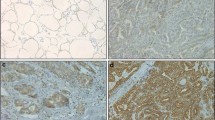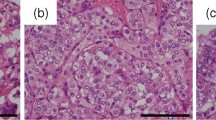Abstract
We previously described that LIM domain containing 2 (LIMD2) overexpression was closely correlated with metastatic process in papillary thyroid carcinoma (PTC). We here evaluated the expression of LIMD2 in a series of non-metastatic and metastatic PTC and their matched lymph node metastases via immunohistochemistry. LIMD2 was expressed in 74 (81%) of primary PTC and 35 (95%) of lymph node metastases. Sub-analysis performed in 37 matched samples demonstrated that in four cases, LIMD2 is expressed in lymph node metastases, while it is not expressed in primary tumors. Moreover, in eight cases, the staining intensity of LIMD2 was stronger in the patient-matched lymph node metastases than in the primary tumors. Next, the expression of LIMD2 was correlated with clinical pathological parameters and BRAF V600E and RET/PTC mutational status. The expression of LIMD2 in primary tumors was correlated with the presence of BRAF V600E mutation (P = 0.0338). Western blot analysis in thyroid cell lines demonstrated that LIMD2 is expressed in two PTC cell lines, while it is not expressed in normal thyroid and follicular thyroid carcinoma cell lines. Importantly, its expression was higher in a PTC cell line that harbors BRAF V600E mutation than in a PTC cell line that harbors RET/PTC1. The available genomic profiling data generated by The Cancer Genome Atlas Research Network confirmed that LIMD2 expression is higher in BRAF-like PTC samples. Our data suggest that LIMD2 may play an important role in the metastatic process of PTC, predominantly in BRAF V600E-positive tumors.



Similar content being viewed by others
References
Pellegriti, G.; Frasca, F.; Regalbuto, C.; Squatrito, S.; Vigneri, R.Worldwide increasing incidence of thyroid cancer: Update on epidemiology and risk factors. Journal of Cancer Epidemiol 2013, 2013, 965212. Doi: https://doi.org/10.1155/2013/965212.
Siegel, R.; Ma, J.; Zou, Z.; Jemal, A.Cancer statistics, 2014. CA Cancer J Clin 2014, 64, 9–29. Doi:https://doi.org/10.3322/caac.21208.
Davies, L.; Welch, H.G.Current thyroid cancer trends in the united states. JAMA Otolaryngol Head Neck Surg 2014, 140, 317–322. Doi: https://doi.org/10.1001/jamaoto.2014.1.
Mao, Y.; Xing, M.Recent incidences and differential trends of thyroid cancer in the USA. Endocr Relat Cancer 2016, 23, 313–322. Doi: https://doi.org/10.1530/ERC-15-0445.
Davies, L.; Morris, L.G.; Haymart, M.; Chen, A.Y.; Goldenberg, D.; Morris, J.; Ogilvie, J.B.; Terris, D.J.; Netterville, J.; Wong, R.J., et al.American association of clinical endocrinologists and american college of endocrinology disease state clinical review: The increasing incidence of thyroid cancer. Endocrine Pract 2015, 21, 686–696. Doi: https://doi.org/10.4158/EP14466.DSCR.
Shi, X.; Liu, R.; Basolo, F.; Giannini, R.; Shen, X.; Teng, D.; Guan, H.; Shan, Z.; Teng, W.; Musholt, T.J., et al.Differential clinicopathological risk and prognosis of major papillary thyroid cancer variants. J Clin Endocrinol Metab 2016, 101, 264–274. Doi: https://doi.org/10.1210/jc.2015-2917.
Leboulleux, S.; Rubino, C.; Baudin, E.; Caillou, B.; Hartl, D.M.; Bidart, J.M.; Travagli, J.P.; Schlumberger, M.Prognostic factors for persistent or recurrent disease of papillary thyroid carcinoma with neck lymph node metastases and/or tumor extension beyond the thyroid capsule at initial diagnosis. J Clin Endocrinol Metab 2005, 90, 5723–5729.
Randolph, G.W.; Duh, Q.Y.; Heller, K.S.; LiVolsi, V.A.; Mandel, S.J.; Steward, D.L.; Tufano, R.P.; Tuttle, R.M.; American Thyroid Association Surgical Affairs Committee's Taskforce on Thyroid Cancer Nodal Surgery. The prognostic significance of nodal metastases from papillary thyroid carcinoma can be stratified based on the size and number of metastatic lymph nodes, as well as the presence of extranodal extension. Thyroid 2012, 22, 1144–1152. Doi: https://doi.org/10.1089/thy.2012.0043.
Haugen, B.R.; Alexander, E.K.; Bible, K.C.; Doherty, G.M.; Mandel, S.J.; Nikiforov, Y.E.; Pacini, F.; Randolph, G.W.; Sawka, A.M.; Schlumberger, M., et al.2015 american thyroid association management guidelines for adult patients with thyroid nodules and differentiated thyroid cancer: The american thyroid association guidelines task force on thyroid nodules and differentiated thyroid cancer. Thyroid 2016, 26, 1–133. Doi: https://doi.org/10.1089/thy.2015.0020.
Wartofsky, L.Management of papillary microcarcinoma: Primum non nocere?J Clin Endocrinol Metab 2012, 97, 1169–1172. Doi: https://doi.org/10.1210/jc.2012-1465.
Zhang, L.; Wei, W.J.; Ji, Q.H.; Zhu, Y.X.; Wang, Z.Y.; Wang, Y.; Huang, C.P.; Shen, Q.; Li, D.S.; Wu, Y.Risk factors for neck nodal metastasis in papillary thyroid microcarcinoma: A study of 1066 patients. J Clin Endocrinol Metab 2012, 97, 1250–1257. Doi: https://doi.org/10.1210/jc.2011-1546.
Pacini, F.; Schlumberger, M.; Dralle, H.; Elisei, R.; Smit, J.W.; Wiersinga, W.; European Thyroid CancerTaskforce. European consensus for the management of patients with differentiated thyroid carcinoma of the follicular epithelium. Eur J Endocrinol 2006, 154, 787–803.
Pitoia, F.; Ward, L.; Wohllk, N.; Friguglietti, C.; Tomimori, E.; Gauna, A.; Camargo, R.; Vaisman, M.; Harach, R.; Munizaga, F., et al.Recommendations of the latin american thyroid society on diagnosis and management of differentiated thyroid cancer. Arq Bras Endocrinol Metabol 2009, 53, 884–887.
American Thyroid Association Guidelines Taskforce on ThyroidNodules and Differentiated Thyroid Cancer; Cooper, D.S.; Doherty, G.M.; Haugen, B.R.; Kloos, R.T.; Lee, S.L.; Mandel, S.J.; Mazzaferri, E.L.; McIver, B., et al.Revised american thyroid association management guidelines for patients with thyroid nodules and differentiated thyroid cancer. Thyroid 2009, 19, 1167–1214. Doi: https://doi.org/10.1089/thy.2009.0110.
Cerutti, J.M.; Oler, G.; Michaluart, P., Jr.; Delcelo, R.; Beaty, R.M.; Shoemaker, J.; Riggins, G.J.Molecular profiling of matched samples identifies biomarkers of papillary thyroid carcinoma lymph node metastasis. Cancer Res 2007, 67, 7885–7892.
Peng, H.; Talebzadeh-Farrooji, M.; Osborne, M.J.; Prokop, J.W.; McDonald, P.C.; Karar, J.; Hou, Z.; He, M.; Kebebew, E.; Orntoft, T., et al.Limd2 is a small lim-only protein overexpressed in metastatic lesions that regulates cell motility and tumor progression by directly binding to and activating the integrin-linked kinase. Cancer Res 2014, 74, 1390–1403. Doi: https://doi.org/10.1158/0008-5472.CAN-13-1275.
Cordioli, M.I.; Moraes, L.; Bastos, A.U.; Besson, P.; Alves, M.T.; Delcelo, R.; Monte, O.; Longui, C.; Cury, A.N.; Cerutti, J.M.Fusion oncogenes are the main genetic events found in sporadic papillary thyroid carcinomas from children. Thyroid 2017, 27, 182–188. Doi: https://doi.org/10.1089/thy.2016.0387.
Fenton, C.L.; Lukes, Y.; Nicholson, D.; Dinauer, C.A.; Francis, G.L.; Tuttle, R.M.The ret/ptc mutations are common in sporadic papillary thyroid carcinoma of children and young adults. J Clin Endocrinol Metab 2000, 85, 1170–1175. Doi: https://doi.org/10.1210/jcem.85.3.6472
Latini, F.R.; Hemerly, J.P.; Oler, G.; Riggins, G.J.; Cerutti, J.M.Re-expression of abi3-binding protein suppresses thyroid tumor growth by promoting senescence and inhibiting invasion. Endocr Relat Cancer 2008, 15, 787–799. Doi: https://doi.org/10.1677/ERC-08-0079.
Schneider, C.A.; Rasband, W.S.; Eliceiri, K.W.Nih image to imagej: 25 years of image analysis. Nat Methods 2012, 9, 671–675.
Cancer Genome Atlas ResearchNetwork. Integrated genomic characterization of papillary thyroid carcinoma. Cell 2014, 159, 676–690. Doi: https://doi.org/10.1016/j.cell.2014.09.050.
Matthews, J.M.; Lester, K.; Joseph, S.; Curtis, D.J.Lim-domain-only proteins in cancer. Nat Rev Cancer 2013, 13, 111–122. Doi: https://doi.org/10.1038/nrc3418.
Brown, S.; Coghill, I.D.; McGrath, M.J.; Robinson, P.A.Role of lim domains in mediating signaling protein interactions. IUBMB Life 2001, 51, 359–364. Doi: https://doi.org/10.1080/152165401753366113
Bach, I.The lim domain: Regulation by association. Mech Dev 2000, 91, 5–17.
Xing, M.; Alzahrani, A.S.; Carson, K.A.; Viola, D.; Elisei, R.; Bendlova, B.; Yip, L.; Mian, C.; Vianello, F.; Tuttle, R.M., et al.Association between braf v600e mutation and mortality in patients with papillary thyroid cancer. Jama 2013, 309, 1493–1501. Doi: https://doi.org/10.1001/jama.2013.3190.
Xing, M.; Alzahrani, A.S.; Carson, K.A.; Shong, Y.K.; Kim, T.Y.; Viola, D.; Elisei, R.; Bendlova, B.; Yip, L.; Mian, C., et al.Association between braf v600e mutation and recurrence of papillary thyroid cancer. J Clin Oncol 2015, 33, 42–50. Doi: https://doi.org/10.1200/JCO.2014.56.8253.
Oler, G.; Cerutti, J.M.High prevalence of braf mutation in a brazilian cohort of patients with sporadic papillary thyroid carcinomas: Correlation with more aggressive phenotype and decreased expression of iodide-metabolizing genes. Cancer 2009, 115, 972–980. Doi: https://doi.org/10.1002/cncr.24118.
Bastos, A.U.; Oler, G.; Nozima, B.H.; Moyses, R.A.; Cerutti, J.M.Braf v600e and decreased nis and tpo expression are associated with aggressiveness of a subgroup of papillary thyroid microcarcinoma. Eur J Endocrinol 2015, 173, 525–540. Doi: https://doi.org/10.1530/EJE-15-0254.
Fraser, S.; Go, C.; Aniss, A.; Sidhu, S.; Delbridge, L.; Learoyd, D.; Clifton-Bligh, R.; Tacon, L.; Tsang, V.; Robinson, B., et al.Braf mutation is associated with decreased disease-free survival in papillary thyroid cancer. World journal of surgery 2016, 40,1618–1624. Doi: https://doi.org/10.1007/s00268-016-3534-x.
Ricarte-Filho, J.C.; Ryder, M.; Chitale, D.A.; Rivera, M.; Heguy, A.; Ladanyi, M.; Janakiraman, M.; Solit, D.; Knauf, J.A.; Tuttle, R.M., et al.Mutational profile of advanced primary and metastatic radioactive iodine-refractory thyroid cancers reveals distinct pathogenetic roles for braf, pik3ca, and akt1. Cancer Res 2009, 69, 4885–4893. Doi: https://doi.org/10.1158/0008-5472.CAN-09-0727.
Fagin, J.A.; Wells, S.A., Jr.Biologic and clinical perspectives on thyroid cancer. The N Engl J Med 2016, 375, 1054–1067. Doi: https://doi.org/10.1056/NEJMra1501993.
Funding
The study was supported by research grants (2014/06570-6) from The São Paulo State Research Foundation (FAPESP) and grant (470441/2013-5) from The Brazilian Research Council (CNPq). A.U.B. (2012/06221-6), G.O. (2012/17545-7), and V.R.C. (2016/25127-1) are FAPESP scholars. J.M.C. is an investigator with the CNPq.
Author information
Authors and Affiliations
Contributions
M.J.C.P.S. performed IHC staining, BRAF V600E mutational status, analyzed and interpreted data, and wrote the manuscript draft. A.U.B. performed BRAF and RET/PTC mutational screening and Western blot analysis, analyzed and interpreted data, prepared all figures, and wrote the manuscript. V.R.C. performed RNA extraction and helped with the RET/PTC screening. R.D. revised all slides and analyzed and interpreted the IHC data. S.C.L. revised the clinical data from all patients. G.A.C.G. helped with the BRAF mutational analysis. H.P. and F.R.J. produced the antibodies, interpreted the data, and revised the manuscript. G.O. was responsible for the sample selection, analyzed and interpreted data, and revised the manuscript. J.M.C. designed the experiments, analyzed the data, revised the manuscript critically for important intellectual content, edited the manuscript, and coordinated the study. All authors reviewed the results and approved the final version of the manuscript.
Corresponding author
Ethics declarations
The study was conducted under the approval of the Review Boards and Research Ethical Committees of UNIFESP (1309/11).
Conflict of Interest
The authors declare that they have no conflict of interest.
Electronic Supplementary Material
Supplementary Fig 1.
LIMD2 expression is higher in BRAF-like samples, according to TCGA. LIMD2 normalized expression data from TCGA research network (paper) was compared in BRAF-like and RAS-like samples. Expression data was normalized by subtracting the mean value of each genomic data from each sample (columns by mean), as suggested by UCSC Cancer Genomics Browser (https://genome-cancer.ucsc.edu/proj/site/help/). (GIF 8 kb)
Rights and permissions
About this article
Cite this article
Pinheiro dos Santos, M.J.C., Bastos, A.U., da Costa, V.R. et al. LIMD2 Is Overexpressed in BRAF V600E-Positive Papillary Thyroid Carcinomas and Matched Lymph Node Metastases. Endocr Pathol 29, 222–230 (2018). https://doi.org/10.1007/s12022-018-9526-7
Published:
Issue Date:
DOI: https://doi.org/10.1007/s12022-018-9526-7




